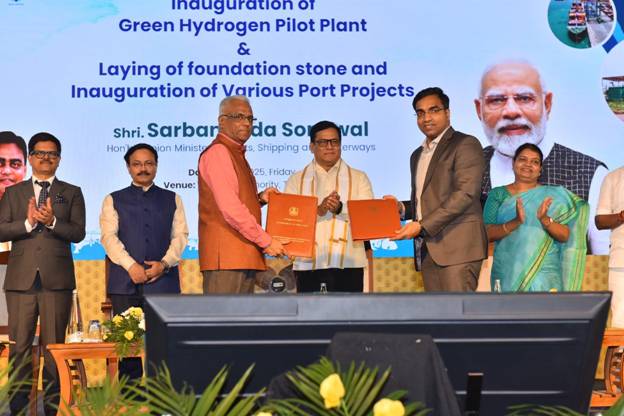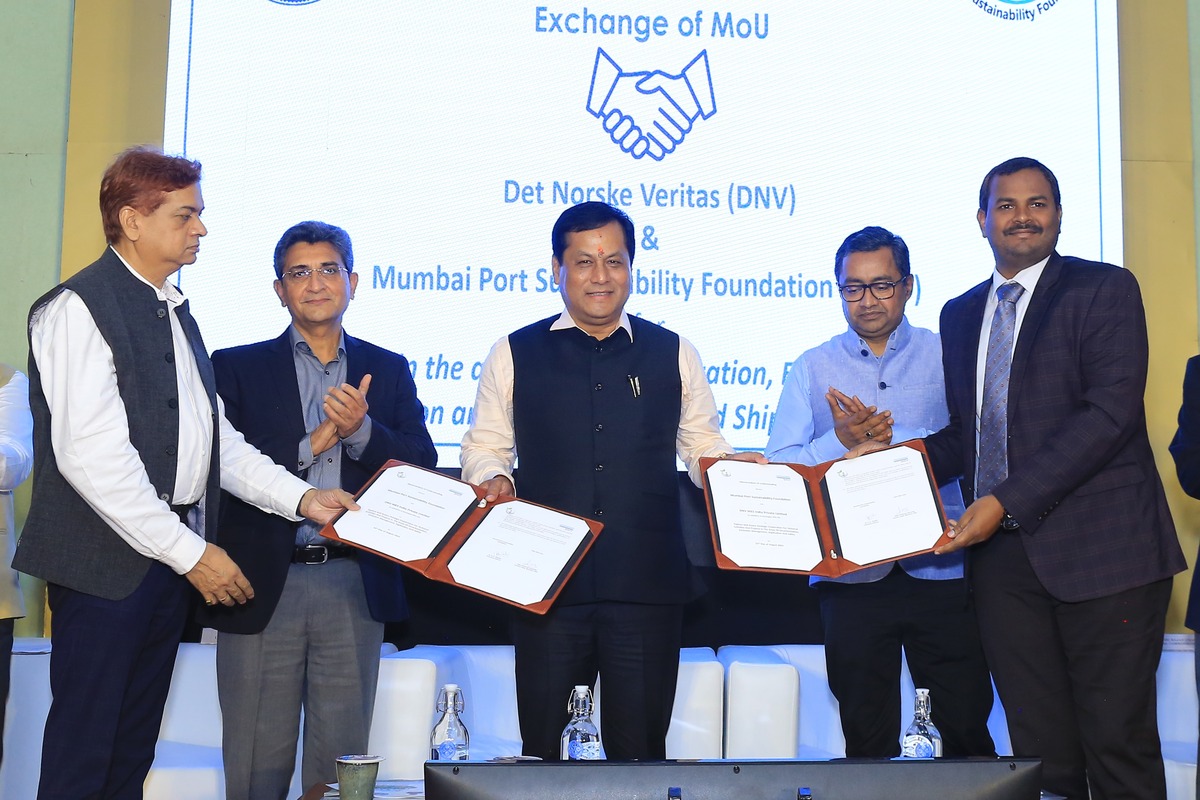Maritime News Tuticorin, Tamil Nadu, India : Union Minister Sarbananda Sonowal’s announcement of India’s first port-based green hydrogen pilot project at V.O. Chidambaranar (VOC) Port marks a significant milestone in the nation’s clean energy transition. However, beneath the ambitious technological advancement lies critical questions about community inclusion and the real impact on local stakeholders who depend on coastal livelihoods.
Historic Green Energy Launch
On September 5, 2025, Minister Sonowal inaugurated the ₹3.87 crore green hydrogen pilot facility with a capacity of 10 Nm³/hr, designed to power streetlights and electric vehicle charging stations within the port colony. This achievement positions VOC Port as the country’s first hydrogen-producing port, aligning with Prime Minister Narendra Modi’s vision of making India a global green energy leader.
“The mission of Viksit Bharat at 2047 blends speed, scale, sustainability and self-reliance,” Sonowal declared, announcing India’s ambitious target to become among the world’s top 10 shipbuilding nations by 2030 and top 5 by 2047. The minister also laid the foundation for a ₹35.34 crore pilot Green Methanol Bunkering and Refuelling Facility with 750 m³ capacity, intended to establish VOC Port as a key green bunkering hub in southern India.
Comprehensive Infrastructure Development
The announcement included multiple complementary projects: a 400 KW rooftop solar power plant elevating the port’s solar capacity to 1.04 MW (the highest among Indian ports), a ₹24.5 crore link conveyor connecting Coal Jetty-I to the stack yard (increasing efficiency by 0.72 MMTPA), foundation stones for a 6 MW wind farm, a ₹90 crore multi-cargo berth, a 3.37 km four-lane road, and the Tamil Nadu Maritime Heritage Museum.
Minister Sonowal highlighted Tamil Nadu’s maritime transformation under Sagarmala, with the state’s three major ports—Chennai, Kamarajar, and VOC—receiving 98 projects worth ₹93,715 crore over 11 years, with 50 already completed and more than ₹16,000 crore invested in modernization.
The Missing Voices: Community Impact Analysis
Despite the celebration of technological achievement, the announcement reveals significant gaps in addressing local community concerns, particularly the fishing communities that have been the backbone of Tuticorin’s coastal economy for generations.
Research indicates that Tuticorin’s fishing communities, including those in nearby Manapad and surrounding coastal villages, face ongoing challenges from port expansion activities. The region supports thousands of fishing families whose livelihoods depend on traditional sea access routes and marine ecosystem health—factors that could be significantly impacted by large-scale industrial hydrogen production and increased shipping traffic.
“While the minister promises ‘thousands of jobs,’ there’s no specific breakdown of how many will actually go to local fishing communities or existing port workers,” observes a maritime policy analyst familiar with the region. “Green hydrogen operations require highly specialized technical skills that the current workforce may not possess without substantial retraining programs.”
Employment Reality Check
The minister’s announcement of “thousands of jobs” generation requires scrutiny against ground realities. Green hydrogen production is a highly automated process typically requiring specialized technicians, process engineers, and safety specialists—skills that may not align with the existing workforce of traditional dock workers, cargo handlers, and fishing community members.
National assessments indicate India faces a significant skills gap in the green hydrogen sector, with 2.83 lakh workforce demand expected by 2030 but limited training infrastructure currently available. This raises questions about whether promised employment will materialize for local communities or primarily benefit external technical professionals.
Environmental and Social Justice Concerns
VOC Port’s green hydrogen development occurs within a densely populated fishing community ecosystem. Historical patterns of port expansion in India have often resulted in community displacement, loss of traditional sea access, and environmental degradation affecting marine livelihoods.
The construction of green methanol facilities and expanded port infrastructure may disrupt fishing operations during the 18-24 month development phase. Additionally, the increased industrial shipping traffic associated with green bunkering hub operations could impact traditional fishing grounds and marine biodiversity.
Timeline Feasibility and Implementation Challenges
While the 10 Nm³/hr pilot facility appears technically feasible within 6-12 months, the larger green methanol facility faces more complex challenges. The ₹35.34 crore investment requires extensive environmental clearances, specialized workforce deployment, and coordination with the proposed Coastal Green Shipping Corridor between Kandla and Tuticorin.
The minister’s ambitious targets for India’s shipbuilding sector advancement—top 10 by 2030 and top 5 by 2047—while inspiring, require massive private investment, technological advancement, and workforce development that extend far beyond green hydrogen production alone.
Critical Recommendations for Inclusive Development
Maritime experts suggest several measures to ensure the green hydrogen initiative benefits local communities rather than displacing them:
Immediate Actions Needed:
- Establish Community Advisory Committees with 50% representation from fishing communities and local workers
- Mandate 40% local hiring quotas for all project phases with preference for affected community members
- Launch dedicated green hydrogen technical training programs for local youth with guaranteed employment pathways
- Implement revenue-sharing mechanisms allocating 3% of facility revenue to community development funds
Long-term Integration Strategies:
- Develop hybrid economic models combining traditional fishing with modern green port operations
- Create opportunities for local fishermen in marine transportation for green hydrogen logistics
- Ensure the Maritime Heritage Museum genuinely represents local fishing community history alongside industrial achievements
Government Response and Corporate Responsibility
The Ministry of Ports, Shipping & Waterways has yet to announce specific community consultation mechanisms or local employment guarantees. Similarly, private sector partners including NTPC (green mobility initiatives) and IPRCL (rail connectivity) have not detailed their community engagement strategies.
“True sustainable development cannot be achieved without including the communities who have been custodians of these coastal resources for generations,” emphasizes a coastal development researcher. “VOC Port has an opportunity to become a model of inclusive green development rather than another case of corporate capture disguised as environmental progress.”
The Path Forward
As VOC Port embarks on this green hydrogen journey, the success of India’s clean energy transition will be measured not only by production capacity and technological innovation but by its ability to create inclusive prosperity for coastal communities.
The project’s MoUs with IPRCL for rail connectivity and NTPC for green mobility initiatives, combined with the minister’s emphasis on “speed, scale, and commitment to India’s growth,” suggest rapid implementation. However, the absence of detailed community consultation timelines raises concerns about whether development will proceed with or without genuine local participation.
Minister Sonowal’s tribute to freedom fighter V.O. Chidambaranar, who “ignited the Swadeshi spirit through shipping,” offers a poignant reminder that sustainable development must honor both technological advancement and community welfare. The question remains whether VOC Port’s green hydrogen revolution will fulfill this dual promise.
Key Success Indicators to Watch:
- Actual local employment numbers versus promised “thousands of jobs”
- Community benefit measurements through fishing cooperative feedback
- Environmental justice indicators including marine ecosystem health
- Cultural preservation outcomes in Heritage Museum development
As India positions itself as a global green hydrogen leader, VOC Port’s experience will likely serve as a template for similar projects across the country’s 200+ minor ports. The stakes extend beyond Tuticorin—this initiative could determine whether India’s maritime transformation becomes a model of inclusive development or continues the historical pattern of community marginalization in the name of progress.




